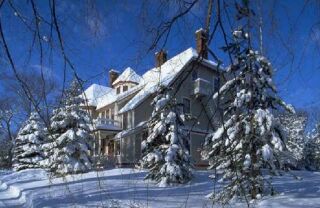|
|
|
CHRISTMAS |
 Canada's Christmas celebrations are drawn from a mixed cultural background including French, English, German, Ukrainian, and First Nations (known in the U.S. as Native Americans). This blend brings about a great deal of variety in the customs and traditions of the nation's Christmas celebrations. The spiritual heart of Christmas for French Canadians has always been Christmas Eve when families would attend Midnight Mass, La Messe de minuit. French Canadians display a creche or Nativity scene and before leaving for Mass family members decorate the Christmas tree and place the creche beneath it. Following the Mass, the family sits down for the reveillon or "awakening" -- a huge banquet. In modern Quebec, some French-Canadian families still wait until New Year's Day for gift giving, however, many have given in to the overwhelming commercialism of Santa Claus from the U.S.
In the past, many Canadians of English ancestry feasted on roast goose or beef along with plum pudding, but the American turkey has made inroads into this tradition. However, they still decorate their homes with pine boughs and kissing balls and sing ancient carols, holding firm to their British heritage in some ways. When German settlers migrated to Canada in the 1700s, they arrived with many of the Christmas traditions that Canadians still cherish today - Christmas trees, carols, Advent calendars, gingerbread houses, cookies and much more. Today, German-Canadian children anxiously await the arrival of Christkindl,representing a messenter from the Christ Child. Their mothers make stollen and decorate hundreds of Christmas cookies. The Tannenbaum is in the place of honor in every home. French Jesuit missionaries established Christianity in native villages in the late 1600's. As a result of this heritage, gift giving, feasting, singing, dancing and drumming, games of strength are all a part of the mid-winter celebrations for the First Nations groups. Children of the Cree Nation visit the homes of relatives on Christmas Eve and a cloth bag is hung for each child. On Christmas morning, the children collect the bags which have been filled with gifts and candy. Missionaries also brought Christianity to the Inuit and today they celebrate Christmas with huge feasts that feature caribou, seal and raw fish, along with turkey. Santa Claus comes for the children and Christmas activities include harpoon throwing, whip cracking, wrestling and igloo building, along with modern day entertainment such as snowmobile racing. In the late 18002s, Ukrainian immigrants arrived in Canada bringing with them a rich blend of Eastern Orthodox and age-old agrarian customs. The religious observance of Christmas for Ukrainian Canadians begins with the Feast of Saint Philip, in which homes, yards and barns are cleaned to perfection. Cleansing of the body and soul takes place too, with fasting and purification. On Christmas Eve, they end a day of fasting with Sviata Vechera, or Holy Supper. Combining agrarian symbols and Christian symbols, twelve dishes are served which represent the twelve disciples and the cycles of the moon. The twelve dishes also represent the most valuable products of the field, garden, and orchard. There is no meat or milk served with the meal as a sign of respect for the farm animals that are depended upon all year long. Prior to the meal, a sheaf of wheat is brought into the house by the father or head of the household. He walks around the inside of the home three times and then places the wheat in a corner of the kitchen or dining room near the family's holy icon. There it remains throughout the Christmas season. This sheaf represents the entire family including departed ancestors and the generations to come. The souls of the family are thought to be in the sheaf and it represents both the Christian belief in an afterlife and the bountiful fertility of the land. |